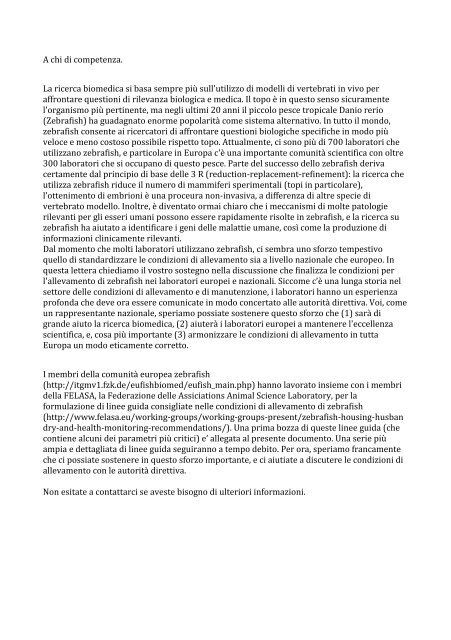A chi di competenza. La ricerca biomedica si basa ... - EuFishBioMed
A chi di competenza. La ricerca biomedica si basa ... - EuFishBioMed
A chi di competenza. La ricerca biomedica si basa ... - EuFishBioMed
You also want an ePaper? Increase the reach of your titles
YUMPU automatically turns print PDFs into web optimized ePapers that Google loves.
A <strong>chi</strong> <strong>di</strong> <strong>competenza</strong>.<br />
<strong>La</strong> <strong>ricerca</strong> biome<strong>di</strong>ca <strong>si</strong> <strong>basa</strong> sempre più sull'utilizzo <strong>di</strong> modelli <strong>di</strong> vertebrati in vivo per<br />
affrontare questioni <strong>di</strong> rilevanza biologica e me<strong>di</strong>ca. Il topo è in questo senso <strong>si</strong>curamente<br />
l'organismo più pertinente, ma negli ultimi 20 anni il piccolo pesce tropicale Danio rerio<br />
(Zebrafish) ha guadagnato enorme popolarità come <strong>si</strong>stema alternativo. In tutto il mondo,<br />
zebrafish consente ai <strong>ricerca</strong>tori <strong>di</strong> affrontare questioni biologiche specifiche in modo più<br />
veloce e meno costoso pos<strong>si</strong>bile rispetto topo. Attualmente, ci sono più <strong>di</strong> 700 laboratori che<br />
utilizzano zebrafish, e particolare in Europa c'è una importante comunità scientifica con oltre<br />
300 laboratori che <strong>si</strong> occupano <strong>di</strong> questo pesce. Parte del successo dello zebrafish deriva<br />
certamente dal principio <strong>di</strong> base delle 3 R (reduction-replacement-refinement): la <strong>ricerca</strong> che<br />
utilizza zebrafish riduce il numero <strong>di</strong> mammiferi sperimentali (topi in particolare),<br />
l’ottenimento <strong>di</strong> embrioni è una proceura non-inva<strong>si</strong>va, a <strong>di</strong>fferenza <strong>di</strong> altre specie <strong>di</strong><br />
vertebrato modello. Inoltre, è <strong>di</strong>ventato ormai <strong>chi</strong>aro che i meccanismi <strong>di</strong> molte patologie<br />
rilevanti per gli esseri umani possono essere rapidamente risolte in zebrafish, e la <strong>ricerca</strong> su<br />
zebrafish ha aiutato a identificare i geni delle malattie umane, così come la produzione <strong>di</strong><br />
informazioni clinicamente rilevanti.<br />
Dal momento che molti laboratori utilizzano zebrafish, ci sembra uno sforzo tempestivo<br />
quello <strong>di</strong> standar<strong>di</strong>zzare le con<strong>di</strong>zioni <strong>di</strong> allevamento <strong>si</strong>a a livello nazionale che europeo. In<br />
questa lettera <strong>chi</strong>e<strong>di</strong>amo il vostro sostegno nella <strong>di</strong>scus<strong>si</strong>one che finalizza le con<strong>di</strong>zioni per<br />
l'allevamento <strong>di</strong> zebrafish nei laboratori europei e nazionali. Siccome c’è una lunga storia nel<br />
settore delle con<strong>di</strong>zioni <strong>di</strong> allevamento e <strong>di</strong> manutenzione, i laboratori hanno un esperienza<br />
profonda che deve ora essere comunicate in modo concertato alle autorità <strong>di</strong>rettiva. Voi, come<br />
un rappresentante nazionale, speriamo pos<strong>si</strong>ate sostenere questo sforzo che (1) sarà <strong>di</strong><br />
grande aiuto la <strong>ricerca</strong> biome<strong>di</strong>ca, (2) aiuterà i laboratori europei a mantenere l'eccellenza<br />
scientifica, e, cosa più importante (3) armonizzare le con<strong>di</strong>zioni <strong>di</strong> allevamento in tutta<br />
Europa un modo eticamente corretto.<br />
I membri della comunità europea zebrafish<br />
(http://itgmv1.fzk.de/eufishbiomed/eufish_main.php) hanno lavorato in<strong>si</strong>eme con i membri<br />
della FELASA, la Federazione delle As<strong>si</strong>ciations Animal Science <strong>La</strong>boratory, per la<br />
formulazione <strong>di</strong> linee guida con<strong>si</strong>gliate nelle con<strong>di</strong>zioni <strong>di</strong> allevamento <strong>di</strong> zebrafish<br />
(http://www.felasa.eu/working‐groups/working‐groups‐present/zebrafish‐hou<strong>si</strong>ng‐husban<br />
dry‐and‐health‐monitoring‐recommendations/). Una prima bozza <strong>di</strong> queste linee guida (che<br />
contiene alcuni dei parametri più critici) e’ allegata al presente documento. Una serie più<br />
ampia e dettagliata <strong>di</strong> linee guida seguiranno a tempo debito. Per ora, speriamo francamente<br />
che ci pos<strong>si</strong>ate sostenere in questo sforzo importante, e ci aiutiate a <strong>di</strong>scutere le con<strong>di</strong>zioni <strong>di</strong><br />
allevamento con le autorità <strong>di</strong>rettiva.<br />
Non e<strong>si</strong>tate a contattarci se aveste bisogno <strong>di</strong> ulteriori informazioni.
Water provi<strong>si</strong>on Recirculating system<br />
with filter, biofilter, UV<br />
unit<br />
Water quality Parameters to be<br />
checked include pH<br />
and conductivity,<br />
nitrite, nitrate.<br />
Stocking den<strong>si</strong>ty 5 adult fish per liter<br />
tank water are<br />
recommended but<br />
actual number depend<br />
on hou<strong>si</strong>ng and<br />
filtering con<strong>di</strong>tions.<br />
Environmental<br />
enrichment<br />
Permanent enrichment<br />
devices (plants etc) are<br />
not recommended.<br />
Fee<strong>di</strong>ng Mixture of dry food<br />
and freshly hatched<br />
artemia. Paramecia<br />
might be used for fry.<br />
Temperature 24.5 -29°C for all<br />
stages (fry and adults)<br />
Daily water<br />
exchange of 5-<br />
20% is<br />
customary<br />
pH range<br />
between 6.5 and<br />
8.0; conductivity<br />
between 250<br />
and 600 µS,<br />
Nitrate (< 2.5<br />
mg/L), nitrite (≤<br />
0.025 mg/L)<br />
See Matthew<br />
(2002) and<br />
Vargesaan<br />
(2007)<br />
There is no<br />
evidence at<br />
present that<br />
adult fish notice,<br />
or benefit from,<br />
such permanent<br />
enrichment.<br />
Parameters to be<br />
checked frequently in<br />
newly setup system, less<br />
frequently in established<br />
system.<br />
Maintaining fish at<br />
den<strong>si</strong>ties of lower than<br />
1fish/liter will usually<br />
cause problems due to<br />
over-fee<strong>di</strong>ng.<br />
Furthermore, it shifts the<br />
sex ration dramatically<br />
(female bias), which is<br />
taken as an in<strong>di</strong>cation for<br />
a stress <strong>si</strong>tuation.<br />
Tank enrichment with<br />
plants, plastic grass or<br />
<strong>si</strong>milar tends to cause<br />
hygienic problems; it<br />
also induces daily and<br />
uncontrolled spawning,<br />
the effects of which on<br />
the fish are unclear at<br />
present. Fee<strong>di</strong>ng live<br />
artemia, however, can be<br />
con<strong>si</strong>dered as tank<br />
enrichment, as it<br />
stimulates natural<br />
predatory behavior.<br />
Artemia fee<strong>di</strong>ng is<br />
con<strong>si</strong>dered as tank<br />
enrichment.<br />
Zebrafish can clearly<br />
tolerate a much wider<br />
range of temperatures,<br />
but around 26°C seems<br />
to be a preferred<br />
temperature.<br />
Single hou<strong>si</strong>ng acceptable Zebrafish are social<br />
animals, and maintaining<br />
<strong>si</strong>ngle fish, or ≤5 fish in
Spawning Separation prior the<br />
day of requested<br />
spawning.<br />
The use of spawning<br />
trays, artificial plant<br />
material or lowering of<br />
the water level can<br />
support spawning and<br />
increase egg numbers.<br />
Light cycle 12:12 to 8:16<br />
dark:light<br />
less than 3 liters should<br />
be kept to a minimum. It<br />
can be necessary,<br />
though, as there is no<br />
methodology to mark<br />
<strong>si</strong>ngle fish.


